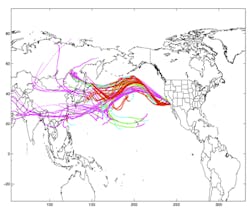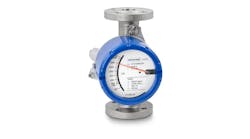Atmospheric chemists at the University of California, San Diego, report the first quantitative measurement of the amount of radiation leaked from the damaged nuclear reactor in Fukushima, Japan, following the devastating earthquake and tsunami earlier this year.
Their estimate, reported August 15 in the early, online edition of the Proceedings of the National Academy of Sciences, is based on a signal sent across the Pacific Ocean when operators of the damaged reactor had to resort to cooling overheated fuel with seawater.
“In any disaster, there’s always a lot to be learned by analysis of what happened,” said senior author Mark Thiemens, dean of the Division of Physical Sciences at UC San Diego, in a prepared statement. “We were able to say how many neutrons were leaking out of that core when it was exposed.”
Air laden with radioactive sulfur can be traced to the source near the Fukushima reactor in Japan using data collected by NOAA.
Image courtesy of Gerardo Dominguez, UC San Diego
On March 28, 2011, 15 days after operators began pumping seawater into the damaged reactors and pools holding spent fuel, Thiemens’ group observed an unprecedented spike in the amount of radioactive sulfur in the air in La Jolla, Calif. They recognized that the signal came from the crippled power plant.
Neutrons and other products of the nuclear reaction leak from fuel rods when they melt. Seawater pumped into the reactor absorbed those neutrons, which collided with chloride ions in the saltwater. Each collision knocked a proton out of the nucleus of a chloride atom, transforming the atom to a radioactive form of sulfur.
Measurements were taken from an instrument at the end of the pier at UC San Diego’s Scripps Institution of Oceanography where Thiemens’ group continuously monitors atmospheric sulfur. Using a model based on NOAA’s observations of atmospheric conditions at the time, the team determined the path air took on its way to the pier over the preceding 10 days and found that it led back to Fukushima.
The researchers calculated that 400 billion neutrons were released per square meter surface of the cooling pools, between March 13, when the seawater pumping operation began, and March 20, 2011.
The trace levels of radiation that reached the California coast never posed a threat to human health, researchers said. Concentrations a kilometer or so above the ocean near Fukushima must have been about 365 times higher than natural levels to account for the levels they observed in California, researchers estimated.
Over a four-day period ending on March 28, researchers measured 1501 atoms of radioactive sulfur in sulfate particles per cubic meter of air, the highest they’ve ever seen in more than two years of recordings at the site.
To read the full UCSD news report, click here.


